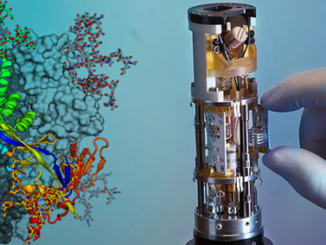Bruker has announced three new orders for DNP-NMR research systems, including a 395 GHz DNP-NMR system, as well as two 263 GHz DNP-NMR systems or major upgrades. This new DNP (Dynamic Nuclear Polarization) hyperpolarization technology will soon be available at the Universities of Düsseldorf, Darmstadt and Frankfurt for use in life science and materials research. All three projects were funded by the German Research Foundation DFG (Deutsche Forschungsgemeinschaft).
 As part of a major instrumentation initiative in Europe, the emerging DNP-NMR field has already benefitted from four already installed Bruker 263 GHz systems in Germany, Switzerland, France and The Netherlands. The field will be further enhanced through three other upcoming high field Bruker DNP-NMR installations, a 395 GHz in Göttingen (Germany), as well as two 527 GHz systems in Utrecht (The Netherlands) and Lyon (France).
As part of a major instrumentation initiative in Europe, the emerging DNP-NMR field has already benefitted from four already installed Bruker 263 GHz systems in Germany, Switzerland, France and The Netherlands. The field will be further enhanced through three other upcoming high field Bruker DNP-NMR installations, a 395 GHz in Göttingen (Germany), as well as two 527 GHz systems in Utrecht (The Netherlands) and Lyon (France).
Dynamic Nuclear Polarization can enhance the sensitivity of solid-state NMR by approximately two orders of magnitude, by transferring polarization from the electron spins to the nuclear spins. With DNP-NMR completely new categories of samples can be investigated with the potential to provide much more detailed spectroscopic insights and a more comprehensive understanding of molecular interactions.
The solid-state DNP-NMR technology commercialized by Bruker finds its origins in the pioneering work of Professors Robert Griffin and Richard Temkin at the Massachusetts Institute of Technology (MIT, Cambridge, MA). The DNP-NMR systems utilize novel Bruker gyrotrons as the high power microwave source, Bruker’s Ascend 89 mm superconducting magnets, and ultra-fast AVANCE III HD electronics for the NMR experiment.
Professor Henrike Heise, head of the Solid-State NMR group at the University of Düsseldorf, said, “The new 395 GHz DNP-NMR system is the key to our realization of new, more detailed structural investigations of macromolecular complexes or structure-function studies on biomolecular complexes, and to further develop new life sciences applications. Furthermore, improved materials science applications such as the study of composite materials, glasses or inhomogeneous polymers will benefit from the dramatically improved sensitivity.”



